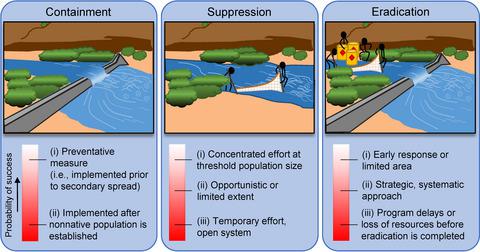当前位置:
X-MOL 学术
›
J. Appl. Ecol.
›
论文详情
Our official English website, www.x-mol.net, welcomes your
feedback! (Note: you will need to create a separate account there.)
Comparing opportunistic and strategic removal efforts to manage invasive fish species using a dynamic multi-state occupancy model
Journal of Applied Ecology ( IF 5.0 ) Pub Date : 2021-09-03 , DOI: 10.1111/1365-2664.14012 Jane S. Rogosch 1, 2 , Julian D. Olden 1
中文翻译:

比较使用动态多状态占用模型管理入侵鱼类物种的机会主义和战略清除工作
更新日期:2021-09-03
Journal of Applied Ecology ( IF 5.0 ) Pub Date : 2021-09-03 , DOI: 10.1111/1365-2664.14012 Jane S. Rogosch 1, 2 , Julian D. Olden 1
Affiliation

|
- Growing ecological and economic impacts of invasive species have heightened the need for new science to inform management that prevents and counteracts their impacts. A persistent challenge is to identify whether removal programs, which range widely in their approach, are successful. Given the variability in dynamic environmental conditions and complex biotic interactions among species, identifying the effectiveness of removal programs intended to lessen nonnative species impacts is inherently difficult. We were interested in whether strategic (i.e. significant coordination and investment) and opportunistic (i.e. temporally periodic and implemented at smaller spatial scales) removal programs result in measurable, and if so, comparable benefits to native fish conservation.
- We applied a novel dynamic co-occurrence model to evaluate nonnative fish removal efforts across the Lower Colorado River Basin (USA), while accounting for potential interspecific species interactions and variable hydrologic regimes. We examined the co-occurrence of two native fishes of conservation concern and two other representative fishes of endemic assemblages, each paired with a nonnative species hypothesized to negatively affect the focal native species.
- Our model results suggest that both strategic and opportunistic removal programs result in lower extinction probabilities for native fishes (1.2 times greater for strategic programs), especially species of conservation concern, when compared to locations and years not subject to removal. Nonnative species presence mediated native species dynamics, most notably by increasing native species extinction probability during drought years regardless of removal program. Removal efforts resulted in modest changes in extinction probabilities for nonnative fishes, but no measurable effect on colonization dynamics.
- Synthesis and applications. Both strategic and opportunistic nonnative fish removal programs can help meet recovery goals for native fishes, even over large areas and long after nonnative species are established. Quantifying dynamics of native and nonnative fishes in a multi-state dynamic co-occurrence model highlights the collective management value of individual programs at regional scales. Increased evaluation of ongoing nonnative removal programs remains critical to ensuring that management actions are warranted and effective in meeting desired conservation outcomes.
中文翻译:

比较使用动态多状态占用模型管理入侵鱼类物种的机会主义和战略清除工作
- 入侵物种对生态和经济的影响越来越大,因此需要新的科学来为预防和抵消其影响的管理提供信息。一个持续存在的挑战是确定方法范围广泛的清除程序是否成功。鉴于动态环境条件的可变性和物种之间复杂的生物相互作用,确定旨在减少非本地物种影响的清除计划的有效性本身就很困难。我们感兴趣的是战略(即重要的协调和投资)和机会主义(即时间周期性和在较小的空间尺度上实施)清除计划是否会产生可衡量的,如果是的话,与本地鱼类保护具有可比性。
- 我们应用了一种新的动态共生模型来评估整个科罗拉多河流域下游(美国)的非本地鱼类清除工作,同时考虑到潜在的种间相互作用和可变的水文状况。我们检查了两种具有保护意义的本地鱼类和另外两种具有代表性的地方性组合鱼类的共存情况,每一种都与一种假设对焦点本地物种产生负面影响的非本地物种配对。
- 我们的模型结果表明,与不受清除的地点和年份相比,战略性和机会性清除计划都会导致本地鱼类的灭绝概率较低(战略计划的 1.2 倍),尤其是保护关注的物种。非本地物种的存在介导了本地物种的动态,最显着的是增加了干旱年份本地物种灭绝的可能性,而不管移除计划如何。清除工作导致非本地鱼类灭绝概率的适度变化,但对殖民动态没有可测量的影响。
- 合成与应用。战略性和机会主义的非本地鱼类清除计划都可以帮助实现本地鱼类的恢复目标,即使是在大面积区域和非本地物种建立很久之后。在多状态动态共现模型中量化本地和非本地鱼类的动态,突出了区域范围内各个项目的集体管理价值。加强对正在进行的非本地迁移计划的评估对于确保管理行动在满足预期保护结果方面是有根据的和有效的仍然至关重要。











































 京公网安备 11010802027423号
京公网安备 11010802027423号